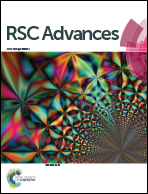Electrospun nanofiber enhanced imidazolium-functionalized polysulfone composite anion exchange membranes
Abstract
A novel method of improving interfacial compatibility in electrospun anion exchange membranes (AEMs) is developed by using imidazolium-functionalized polysulfone (IMPSF) as both electrospun fiber mats and interfiber voids filler. Scanning electron microscopy (SEM) illustrates the defect-free and fiber-retained morphology of the IMPSF electrospun AEMs. Transmission electron microscopy (TEM) shows better aggregation of ion clusters in the IMPSF electrospun AEMs. As a result, the electrospun AEMs prepared in the present work exhibit much higher hydroxide conductivity increment than most reported electrospun AEMs (around 1.7 folds in 20 °C water and 100 folds at 60 °C, relative humidity (RH) 40% as compared with the corresponding cast AEMs). Excellent interfacial compatibility and microphase separation morphology also promote swelling resistance and mechanical and alkaline stabilities of the IMPSF electrospun composite AEMs. Compared with the cast AEMs, tensile strength increment is up to 22%, alkaline stability increases more than one fold after immersing in 1 M KOH at 60 °C for 24 h. Results in the present work are helpful to componential design of the electrospun AEMs.


 Please wait while we load your content...
Please wait while we load your content...